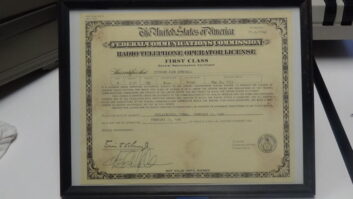Text has been updated on 9/25.
Radio stations in Puerto Rico were facing numerous obstacles to returning to normal service five days after Hurricane Fiona swept the U.S. territory.
Roughly half of the archipelago’s 125 stations were either operating with emergency generators or were off the air as of Sept. 22, according to Felix Bonnet, executive director of the Puerto Rico Broadcasters Association.
He told Radio World that numerous factors have hampered stations returning to service. These include lack of power; difficulty accessing transmitter sites due to flooding or forest debris; flooding of studios; damage to towers and antenna tuning units; lack of internet or microwave links; and the absence of personnel who are dealing with storm damage themselves.
“Apart from those issues, there is now a diesel shortage due to demand and distribution logistics,” he said.
“Radio by law in Puerto Rico qualifies as ‘first responders’ for emergency supplies, but even that privilege is useless because of logistics or scarcity.”
Bonnet himself was without power when he emailed Radio World Thursday using his cellphone.
He said then that some stations have been able to maintain their internet streaming and are airing public service programming to support authorities and first responders. Radio World reached out to Bonnet for an update over the weekend and will post new information as we get it.
The FCC has supported Puerto Rico broadcasters by issuing extensions on regulatory fees and EEO report deadlines. Bonnet said the association also has received offers of help from the National Alliance of State Broadcasters Associations, the National Association of Broadcasters and the Broadcasters Foundation of America.
Fiona struck most heavily in the southern and western part of Puerto Rico, with the San Juan are less affected. Bonnet said this has allowed better coordination of assistance than was the case five years ago during the Maria emergency.
NAB spokeswoman Ann Marie Cumming told Radio World, “Our hearts go out to Puerto Rico, and we commend the heroic broadcasters in Puerto Rico that continue to provide lifesaving information and updates to those affected by this devastating hurricane.”
Some areas got over 30 inches of rain, NPR reports, and hundreds of thousands of people are still without water.
As of midday Sunday Sept. 25, seven radio stations officially reported still being off the air via the FCC’s Disaster Information Reporting System; but participation in that system is voluntary.
About 19% cell service sites in the affected area still were down as of midday Sunday, according to the FCC’s Communications Status Report. The commission noted that the number of cell sites down does not necessarily correspond to the availability of service because cell infrastructure overlaps and providers may use temporary facilities to fill in.
Update on the evening of Sept. 25: Bonnet tells Radio World, “Most stations are restoring service through emergency temporary repairs and using borrowed equipment, although some are still off. PR’s only electricity transmission company, LUMA, has slowly been restoring power. As of this writing, they claim 50% of their clients are ok and promising that by Friday 91% will be restored. The predicament is that where still power is unavailable, there is a diesel fuel scarcity, apparently due to an unusual high demand combined with distribution logistics. After Hurricane Maria in 2017 and the earthquakes, emergency power is now a household and business must. hat has resulted in a huge demand. The government agencies, hospitals, communications companies, food providers (supermarkets) and broadcast industry now compete with thousands of households that installed emergency plants.”
[Related: “FCC Reviews Comments on Network Resiliency”]










